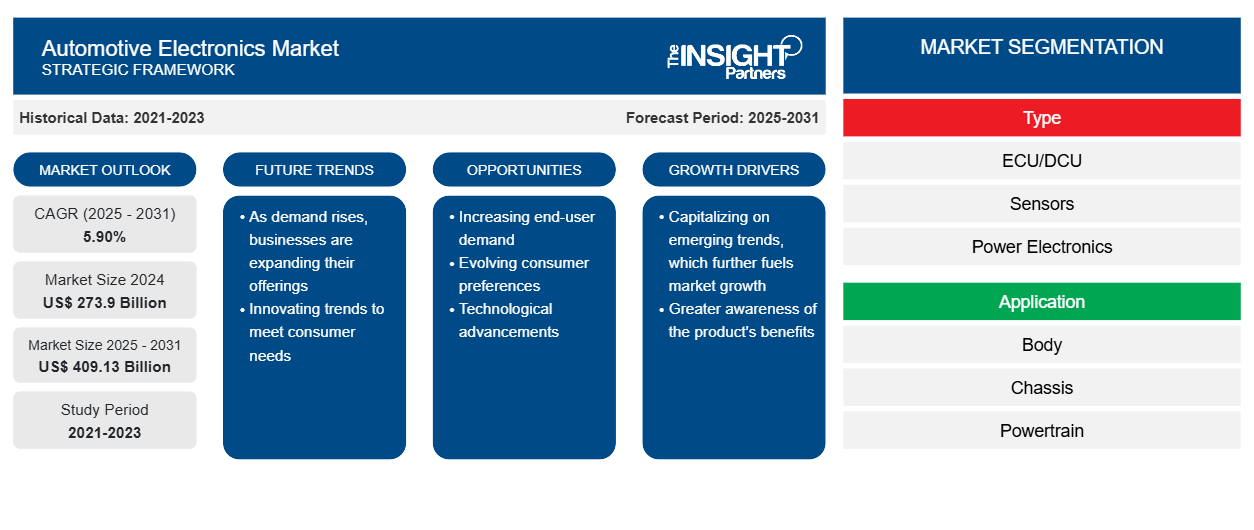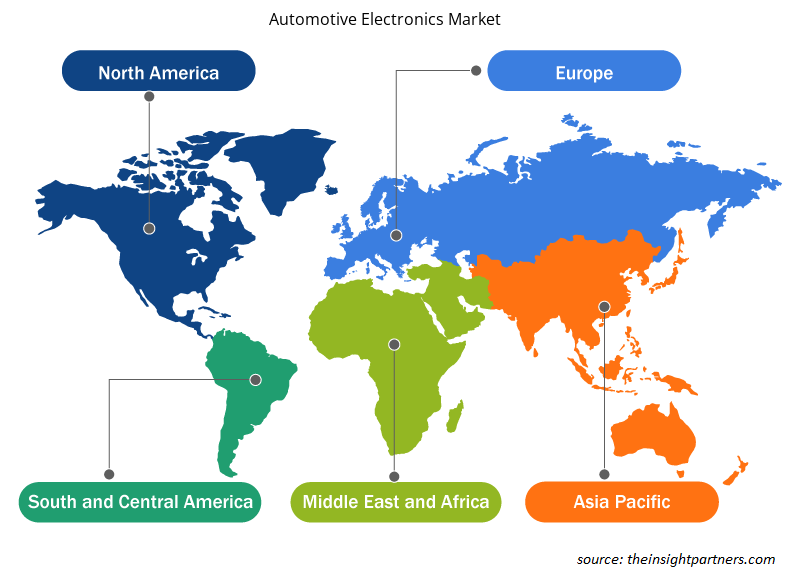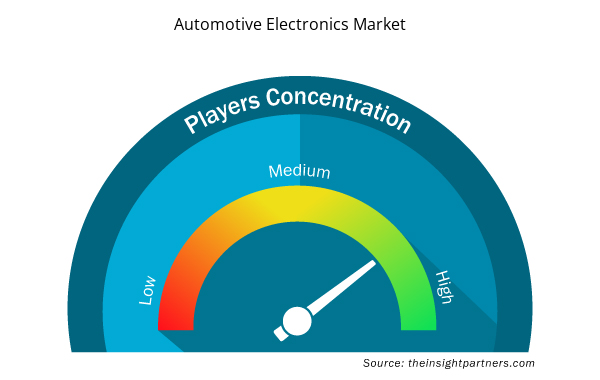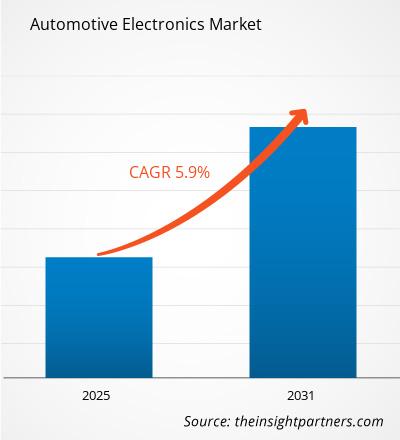[Research Report] The automotive electronics market is expected to grow from US$ 244.23 billion in 2022 to US$ 385.43 billion by 2031; it is estimated to grow at a CAGR of 5.9% from 2022 to 2031.
Analyst Perspective:
The automotive electronics market has witnessed significant growth in recent years, driven by rising sales of passenger cars and commercial vehicles with increased demand for convenience and driving comfort. Manufacturers are focused on improving fuel efficiency, driving performance, and rider and driver’s comfort. The rising necessity to enhance everything from fuel efficiency to driver safety is causing the increased demand for the number of electronic components to grow with time. As a result, more mechanical systems are being replaced with electrical and electronic ones in mechanisms. Significantly, high-tech automobiles have evolved into auto electronic engines with computer-controlled systems during the forecast period. A contemporary automobile has approximately hundreds of electronic systems. The development of vehicle electronics technology has elevated the simple act of driving to a luxurious, comfortable experience. Embedded systems are now widely used in the manufacturing of automobiles. The rising development of advanced technologies such as machine learning, IoT and artificial intelligence (AI) in automobiles is expected to create lucrative opportunities for market growth. Vehicles are equipped with automated driving assistance. With increasing demand for in-vehicle safety features, automotive infotainment system drives the global automotive electronics market growth.
Furthermore, the rising demand for advanced analog power conversion devices in vehicles driven by the rise in sales and production of hybrid and all-electric vehicles drives the market growth. With increased vehicle production, the global automotive electronics market will continue to expand steadily. According to the European Automobiles Association, in 2022, more than 85.4 million vehicles were manufactured globally, an increase of 5.7% compared to the previous year, 2021. There are many applications of automotive electronic systems, such as car parking systems, remote keyless entry, security and personal infotainment systems, GPS location systems, and e-call functionality. This application requires automotive electronics systems to provide additional features to the vehicles.
Market Overview:
Automotive electronics are the electronic components used in the production of vehicles, including from the engine management to the external automotive infotainment systems. These automotive electronics components include ignition systems, audio-radio systems, automotive telematics, entertainment systems, automotive dashboards, and others.
Automotive electronics includes several components, including transistors, diodes, resistors, capacitors, and other common electrical components such as switches and lighting. Individual cables or printed circuit boards are used to link each of these parts. Automotive electronic systems also include specialized parts known as sensors or actuators that allow the electronic system to communicate with the relevant vehicle mechanical systems.
Customize This Report To Suit Your Requirement
You will get customization on any report - free of charge - including parts of this report, or country-level analysis, Excel Data pack, as well as avail great offers and discounts for start-ups & universities
Automotive Electronics Market: Strategic Insights

- Get Top Key Market Trends of this report.This FREE sample will include data analysis, ranging from market trends to estimates and forecasts.
Customize This Report To Suit Your Requirement
You will get customization on any report - free of charge - including parts of this report, or country-level analysis, Excel Data pack, as well as avail great offers and discounts for start-ups & universities
Automotive Electronics Market: Strategic Insights

- Get Top Key Market Trends of this report.This FREE sample will include data analysis, ranging from market trends to estimates and forecasts.
Market Driver:
Increased Demand for Autonomous and Comfortable Driving with Increasing Automotive Production to Drive Growth of Automotive Electronics Market
Rising sales and the production of passenger cars and light commercial vehicles around the globe, with increased disposable income of the people, drive the market growth. According to the European Associations for Automotive Manufacturing, global vehicle production reached around 85.4 million in 2022, increased by 5.7% compared to 2021. Increased demand for automotive electronics and software drives the market growth during the forecast period. In automotive electronics, domain control unit (DCU) and electronic control unit segments are expected to have the largest share in 2022, and electronic control unit (ECU) sales are increasing at the highest CAGR during the forecast period. Also, the automotive sensors requirement in the overall automotive electronics industry is growing at a rapid pace with increased demand for AD/ADAS sensors.
Changes in consumer preferences, laws that prioritize safety and permit higher levels of autonomous driving, and technological advancements like the availability of high-performance computers, sophisticated software, or light detection and ranging (LiDAR) sensors will all accelerate the adoption of driver assistance systems and AD. For instance, by 2031, the demand for Level 2 advanced driver assistance systems (ADAS) is expected to show an annual growth of up to 30%, partly owing to rules requiring these sensors in all new vehicles. The German automaker, which had previously made a costly bet on Ford's now closed self-driving car unit, Argo, has been partnering with supplier Mobileye in a strategic shift.
Further, the global automotive electronics market growth is driven by rising demand for connected vehicles with additional features such as location-based GPS services, in-car payments, and infotainment systems. The market is driven by increasingly stringent rules and regulations to automate the fuel efficiency of vehicles, with increased EV sales and increasing premium features-based vehicles. The rapid adoption of green transportation, such as electric and hybrid vehicles, drives the global automotive electronics market growth. These electric vehicles consist of advanced electronic systems to achieve maximum reliability and efficiency, which is expected to create ample opportunity for the automotive electronics market growth.
Further, the rising development of autonomous cars with self-driving features is expected to create ample opportunity in the upcoming future. In July 2023, Volkswagen planned to launch self-driving autonomous vehicles for goods delivery and ride-hailing services in Austin, Texas, US, by 2031.
Segmental Analysis:
Based on type, the market is segmented into ECU/DCU, sensors, power electronics, and others. The ECU/DCU segment held the largest share of the market in 2022. In contrast, the power electronics segment is anticipated to register the highest CAGR in the market during the forecast period. ECU/DCU has emerged as the dominant share in the automotive electronics market, owing to rising demand for connected cars. According to the International Energy Agency (IEA), the sales of connected cars increased by 12% in 2022. The US and Europe remained the dominant market share for connected cars, followed by Japan and South Korea.
Further, rising consumers' preference for additional features-based vehicles such as enhanced GPS & navigation systems, in-vehicle infotainment systems, predictive maintenance, and over-the-air capabilities are driving the ECU/DCU segmental growth. All of such features are provided in the connected cars. ECU/DCU is used to automate the vehicles using various sensors and electronics capabilities.
Regional Analysis:
The Asia Pacific automotive electronics market, is expected to dominate the global automotive electronics market owing to the presence of several automotive component manufacturers and increasing sales of EVs and hybrid vehicles. Electric car sale has seen exponential growth in recent years, with sale surpassing more than 10 million in 2022 and is expected to reach 14 million by 2031. With total vehicle sales, around 14% of the automotives sold are electric. In Asia Pacific, China dominated global sales of the electric vehicles market. China accounted for more than 60% of the world’s electric car sales. China accounts for more than half of the world’s electric cars on roads, and the country exceeded its sales target for energy-efficient vehicle sales.
Further, Europe is growing at a rapid pace with increasing sales of EVs and hybrid vehicles. Electric car sales in Europe increased by more than 15% in 2022. Also, in Europe, one in every five cars being sold were electric in 2022.
The rising advancement in the electronic component in the automotive industry across the Indian and Chinese markets has strengthened the market growth. China and India are increasing the popularity of advanced vehicles at a rapid pace owing to an increase in vehicle sales and rising demand for premium vehicles. Asia Pacific OEMs and suppliers have a lucrative opportunity to utilize advanced electronics owing to rising sales and urbanization with growth in population.
Further, North American countries such as the US and Canada are growing at a rapid pace with rising adoption of autonomous vehicles, EVs and connected car sales. Electric car sales in the US show growth of 55% in 2022 compared to 2021. Such rising sale of EVs is expected to create ample opportunity for the autonomous electronics market growth during the forecast period.
North America comprises several leading automotive brand manufacturers, including General Motors Co., Ford Motor Co., PACCAR Inc., Tesla Inc., Navistar International Corp, Rivian Automotive Inc., and BMW AG. These leading players require several automotive components to manufacture commercial and passenger vehicles. In North America, the government supports increasing the local production of automobiles and their parts. Hence, the United States government has imposed several favorable policies in support of manufacturing automotive components in North America.
Key players operating in Canada are making substantial investments to increase in-house production of the vehicles. For instance, between 2021 and 2022, Canadian subsidiaries of U.S. automotive manufacturers have made substantial investments in Canada. In 2021, General Motors invested more than US$ 785 million, Ford Motors invested US$1.5 billion, and Stellantis invested US$ 1.14 billion to expand their production facilities. Such an increase in production activities with significant investment is expected to drive the global automotive electronics market growth.
Key Player Analysis:
The automotive electronics market analysis consists of the players such as Continental AG, Robert Bosch GmbH, SONY Corporation, Aptiv PLC, Hyundai Mobis, ZF Friedrichshafen AG, Autoliv Inc., Magna International Inc., Aisin Seiki Co. Ltd, Philips N.V. and Among the players in the automotive electronics market.
Recent Developments:
The strategies adopted by these players include mergers and acquisitions, new product launches, and mergers and acquisitions. Some of the key strategies adopted by the market players are listed below:
- In January 2023- HARMAN International Industries, incorporated a subsidiary of the Samsung Electronics Ltd. Automotive infotainment manufacturer, launched advanced electronics products for the vehicles. The company showcased its product offering at the CES event held in 2023. HARMAN showcased several product lines, including Ready Display, Ready Care, Ready on Demand, Ready Vision, Ready Upgrade, Sound & Vibration Sensor and External Microphones for the automotive.
- In December 2019, Renesas Electronics Corporation, a supplier of advanced semiconductors, launched two advanced microcontrollers (MCUs) for automotive electronics. These MCUs were used in the automotive sensor and actuator applications supporting the next-generation automotive electronic and electrical systems.
Automotive Electronics Market Regional Insights
The regional trends and factors influencing the Automotive Electronics Market throughout the forecast period have been thoroughly explained by the analysts at Insight Partners. This section also discusses Automotive Electronics Market segments and geography across North America, Europe, Asia Pacific, Middle East and Africa, and South and Central America.

- Get the Regional Specific Data for Automotive Electronics Market
Automotive Electronics Market Report Scope
| Report Attribute | Details |
|---|---|
| Market size in 2024 | US$ 273.9 Billion |
| Market Size by 2031 | US$ 409.13 Billion |
| Global CAGR (2025 - 2031) | 5.90% |
| Historical Data | 2021-2023 |
| Forecast period | 2025-2031 |
| Segments Covered |
By Type
|
| Regions and Countries Covered | North America
|
| Market leaders and key company profiles |
Automotive Electronics Market Players Density: Understanding Its Impact on Business Dynamics
The Automotive Electronics Market market is growing rapidly, driven by increasing end-user demand due to factors such as evolving consumer preferences, technological advancements, and greater awareness of the product's benefits. As demand rises, businesses are expanding their offerings, innovating to meet consumer needs, and capitalizing on emerging trends, which further fuels market growth.
Market players density refers to the distribution of firms or companies operating within a particular market or industry. It indicates how many competitors (market players) are present in a given market space relative to its size or total market value.
Major Companies operating in the Automotive Electronics Market are:
- Denso Corporation
- HGM Automotive Electronics
- Hitachi, Ltd.
- Infineon Technologies AG
- Microchip Technology Inc.
Disclaimer: The companies listed above are not ranked in any particular order.

- Get the Automotive Electronics Market top key players overview
- Historical Analysis (2 Years), Base Year, Forecast (7 Years) with CAGR
- PEST and SWOT Analysis
- Market Size Value / Volume - Global, Regional, Country
- Industry and Competitive Landscape
- Excel Dataset


- Bioremediation Technology and Services Market
- Surety Market
- Data Center Cooling Market
- Online Recruitment Market
- Cling Films Market
- Sleep Apnea Diagnostics Market
- Adaptive Traffic Control System Market
- Vaginal Specula Market
- Artificial Intelligence in Healthcare Diagnosis Market
- Piling Machines Market

Report Coverage
Revenue forecast, Company Analysis, Industry landscape, Growth factors, and Trends

Segment Covered
Type, Application, Vehicle Type

Regional Scope
North America, Europe, Asia Pacific, Middle East & Africa, South & Central America

Country Scope
This text is related
to country scope.
Trends and growth analysis reports related to Electronics and Semiconductor : READ MORE..
The List of Companies
1. Denso Corporation
2. HGM Automotive Electronics
3. Hitachi, Ltd.
4. Infineon Technologies AG
5. Microchip Technology Inc.
6. NXP Semiconductor
7. Robert Bosch GmbH
8. SONY INDIA
9. Texas Instruments Incorporated
10. ZF Friedrichshafen AG

 Get Free Sample For
Get Free Sample For